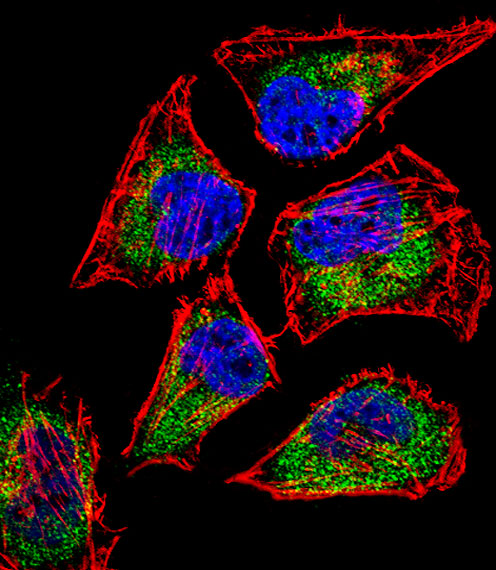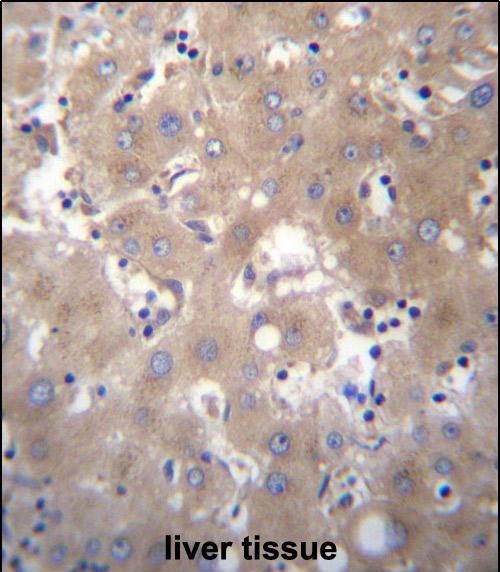SIX5 Antibody (Center)
Affinity Purified Rabbit Polyclonal Antibody (Pab)
- SPECIFICATION
- CITATIONS
- PROTOCOLS
- BACKGROUND

Application
| IF, IHC-P, WB, E |
|---|---|
| Primary Accession | Q8N196 |
| Other Accession | P70178, NP_787071.2 |
| Reactivity | Human |
| Predicted | Mouse |
| Host | Rabbit |
| Clonality | Polyclonal |
| Isotype | Rabbit IgG |
| Calculated MW | 74562 Da |
| Antigen Region | 257-286 aa |
| Gene ID | 147912 |
|---|---|
| Other Names | Homeobox protein SIX5, DM locus-associated homeodomain protein, Sine oculis homeobox homolog 5, SIX5, DMAHP |
| Target/Specificity | This SIX5 antibody is generated from rabbits immunized with a KLH conjugated synthetic peptide between 257-286 amino acids from the Central region of human SIX5. |
| Dilution | IF~~1:10~50 IHC-P~~1:10~50 WB~~1:1000 E~~Use at an assay dependent concentration. |
| Format | Purified polyclonal antibody supplied in PBS with 0.09% (W/V) sodium azide. This antibody is purified through a protein A column, followed by peptide affinity purification. |
| Storage | Maintain refrigerated at 2-8°C for up to 2 weeks. For long term storage store at -20°C in small aliquots to prevent freeze-thaw cycles. |
| Precautions | SIX5 Antibody (Center) is for research use only and not for use in diagnostic or therapeutic procedures. |
| Name | SIX5 |
|---|---|
| Synonyms | DMAHP |
| Function | Transcription factor that is thought to be involved in regulation of organogenesis. May be involved in determination and maintenance of retina formation. Binds a 5'-GGTGTCAG-3' motif present in the ARE regulatory element of ATP1A1. Binds a 5'-TCA[AG][AG]TTNC-3' motif present in the MEF3 element in the myogenin promoter, and in the IGFBP5 promoter (By similarity). Thought to be regulated by association with Dach and Eya proteins, and seems to be coactivated by EYA1, EYA2 and EYA3 (By similarity). |
| Cellular Location | Cytoplasm. Nucleus {ECO:0000255|PROSITE-ProRule:PRU00108, ECO:0000269|PubMed:12500905} |
| Tissue Location | Expressed in adult but not in fetal eyes. Found in corneal epithelium and endothelium, lens epithelium, ciliary body epithelia, cellular layers of the retina and the sclera |

Thousands of laboratories across the world have published research that depended on the performance of antibodies from Abcepta to advance their research. Check out links to articles that cite our products in major peer-reviewed journals, organized by research category.
info@abcepta.com, and receive a free "I Love Antibodies" mug.
Provided below are standard protocols that you may find useful for product applications.
Background
The protein encoded by this gene is a homeodomain-containing transcription factor that appears to function in the regulation of organogenesis. This gene is located downstream of the dystrophia myotonica-protein kinase gene. Mutations in this gene are a cause of branchiootorenal syndrome type 2.
References
Yoshida, T., et al. Int. J. Mol. Med. 25(4):649-656(2010)
Oguri, M., et al. Am. J. Hypertens. 23(1):70-77(2010)
Hoskins, B.E., et al. Am. J. Hum. Genet. 80(4):800-804(2007)
Sato, S., et al. Hum. Mol. Genet. 11(9):1045-1058(2002)
Fougerousse, F., et al. J. Muscle Res. Cell. Motil. 23(3):255-264(2002)
If you have used an Abcepta product and would like to share how it has performed, please click on the "Submit Review" button and provide the requested information. Our staff will examine and post your review and contact you if needed.
If you have any additional inquiries please email technical services at tech@abcepta.com.













 Foundational characteristics of cancer include proliferation, angiogenesis, migration, evasion of apoptosis, and cellular immortality. Find key markers for these cellular processes and antibodies to detect them.
Foundational characteristics of cancer include proliferation, angiogenesis, migration, evasion of apoptosis, and cellular immortality. Find key markers for these cellular processes and antibodies to detect them. The SUMOplot™ Analysis Program predicts and scores sumoylation sites in your protein. SUMOylation is a post-translational modification involved in various cellular processes, such as nuclear-cytosolic transport, transcriptional regulation, apoptosis, protein stability, response to stress, and progression through the cell cycle.
The SUMOplot™ Analysis Program predicts and scores sumoylation sites in your protein. SUMOylation is a post-translational modification involved in various cellular processes, such as nuclear-cytosolic transport, transcriptional regulation, apoptosis, protein stability, response to stress, and progression through the cell cycle. The Autophagy Receptor Motif Plotter predicts and scores autophagy receptor binding sites in your protein. Identifying proteins connected to this pathway is critical to understanding the role of autophagy in physiological as well as pathological processes such as development, differentiation, neurodegenerative diseases, stress, infection, and cancer.
The Autophagy Receptor Motif Plotter predicts and scores autophagy receptor binding sites in your protein. Identifying proteins connected to this pathway is critical to understanding the role of autophagy in physiological as well as pathological processes such as development, differentiation, neurodegenerative diseases, stress, infection, and cancer.




